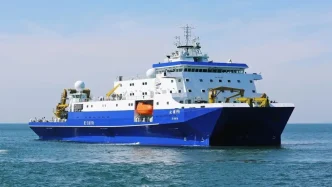The Philippine Coast Guard (PCG) has intercepted three Chinese research vessels operating without authorization within the country’s exclusive economic zone (EEZ), escalating tensions in the contested South China Sea. On July 31, the PCG reported the unauthorized entry of the ships, suspected of conducting illegal marine scientific research, prompting immediate action to safeguard national maritime interests.
Unauthorized Incursions in Philippine Waters
The PCG identified the three vessels as Bei Diao 996, Xiang Yang Hong 10, and Zhuhai Yun, each equipped with advanced research capabilities. According to PCG spokesperson Jay Tarriela, the vessels were detected through Canada’s Dark Vessel Detection Program, a satellite tracking system designed to monitor ships that disable their tracking devices to avoid surveillance. Such “dark vessels” pose significant security risks to maritime communities by concealing their activities.
The Bei Diao 996, described as China’s largest deep-sea research test ship and the world’s biggest small waterplane area twin hull (SWATH) catamaran, was last spotted 185 nautical miles off Zambales. However, Tarriela noted that it had been conducting operations closer to Bajo de Masinloc, a reef located approximately 40 nautical miles west of the Zambales coast, well within Philippine waters. The vessel, which left Guangdong Province on June 16 and entered the EEZ a week later, boasts dual-use capabilities for both civilian and scientific research, including testing underwater acoustic sensors and sonar equipment.
Simultaneously, the Xiang Yang Hong 10 and Zhuhai Yun breached Philippine waters on June 25, appearing 200 nautical miles off Bolinao, Pangasinan. Their coordinated deployment near Balagtas Reef suggested a joint research mission, with both ships later positioning themselves 195 nautical miles from Rizal, Palawan. The Xiang Yang Hong 10, a multi-role research vessel, is capable of deep-sea surveys and operating unmanned autonomous underwater vehicles for seafloor mapping. It also features ice-breaking capabilities and precision positioning technology. Meanwhile, the Zhuhai Yun, billed as the world’s first intelligent unmanned drone carrier, is designed for oceanographic research but holds significant military potential, including mapping submarine routes and deploying smart mines, according to the PCG.
In response, PCG Commandant Admiral Ronnie Gil Gavan ordered an immediate interception to challenge the vessels over their suspected activities. Tarriela emphasized the agency’s commitment to enforcing laws and protecting national interests, stating, “The PCG remains committed to safeguarding the maritime domain and will take all necessary actions.”
Broader Context of South China Sea Tensions
These incursions are the latest in a series of maritime disputes between the Philippines and China in the South China Sea, a resource-rich region claimed in part or whole by multiple nations, including Vietnam, Malaysia, Brunei, and Taiwan. Beijing’s expansive claims, often referred to as the Nine-Dash line, were invalidated by a 2016 ruling from the Permanent Court of Arbitration in The Hague, which sided with the Philippines. Despite the ruling, China has continued to assert its presence through military patrols, artificial island construction, and, as seen in this case, research expeditions that neighboring countries view as encroachments on their sovereign rights.
The South China Sea holds strategic importance not only for its vast fisheries and potential oil and gas reserves but also as a critical global trade route, with trillions of dollars in commerce passing through annually. For the Philippines, protecting its EEZ—extending 200 nautical miles from its coastline—is vital for national security and economic stability. Unauthorized research activities, particularly those with potential military applications, raise concerns about surveillance and data collection that could undermine Manila’s control over its maritime domain.
The use of “dark vessel” tactics, where ships disable their Automatic Identification System (AIS) to evade detection, further complicates enforcement efforts. Canada’s Dark Vessel Detection Program, which employs satellite imagery to track such activities, has become a crucial tool for countries like the Philippines in monitoring illicit maritime behavior. However, the sophistication of vessels like the Zhuhai Yun, with its autonomous drone capabilities, underscores the technological asymmetry in the region, where smaller nations often struggle to match China’s naval and research prowess.
Regional and International Implications
The presence of Chinese research vessels in Philippine waters is not an isolated incident but part of a broader pattern of maritime assertiveness by Beijing. Similar encounters have been reported in the EEZs of Vietnam and Malaysia, where Chinese ships have conducted surveys or interfered with local fishing and energy exploration activities. These actions often spark diplomatic protests and, occasionally, naval standoffs, as affected countries seek to defend their rights under the United Nations Convention on the Law of the Sea (UNCLOS), which establishes the framework for EEZ boundaries and resource rights.
For the Philippines, the repeated incursions test its strategic partnerships, particularly with the United States, a treaty ally under the 1951 Mutual Defense Treaty. Washington has repeatedly affirmed its commitment to defending Manila in the event of an armed attack in the South China Sea, though it has stopped short of direct intervention in non-military disputes like research vessel intrusions. Recent years have seen increased joint military exercises and agreements, such as the Enhanced Defense Cooperation Agreement (EDCA), which grants the US access to additional Philippine bases, partly as a counterbalance to Chinese activities in the region.
At the regional level, the Association of Southeast Asian Nations (ASEAN) has struggled to present a unified front on South China Sea disputes, largely due to differing economic ties with China among member states. While countries like Vietnam and the Philippines advocate for a binding Code of Conduct (COC) to govern maritime behavior, progress has been slow, with negotiations often stalled by disagreements over enforcement mechanisms and territorial definitions. The latest incident with the Chinese research vessels is likely to renew calls for a finalized COC, though analysts remain skeptical about its near-term realization given the geopolitical complexities.
Domestic Reactions and Policy Challenges
Within the Philippines, the government faces domestic pressure to adopt a firmer stance against Chinese incursions. Fishermen and coastal communities, particularly in areas like Zambales and Palawan, have long complained of losing access to traditional fishing grounds due to the presence of foreign vessels and China’s militarized outposts. Public sentiment, often fueled by viral social media posts and local news coverage, frequently demands stronger military patrols and diplomatic action, though Manila must balance these calls with the risk of escalating tensions into open conflict.
The administration of President Ferdinand Marcos Jr. has taken a more assertive approach compared to his predecessor, Rodrigo Duterte, who prioritized economic cooperation with Beijing. Marcos has sought to strengthen alliances with the US, Japan, and Australia while pursuing legal and diplomatic avenues to challenge China’s actions. However, the PCG’s capacity to monitor and intercept vessels across the vast EEZ remains limited, with aging ships and insufficient funding hampering enforcement efforts. International support, such as satellite data from Canada and joint patrols with allies, has helped bridge some gaps, but sustained investment in maritime defense is critical for long-term sovereignty protection.
Looking Ahead: A Persistent Flashpoint
As the Philippine Coast Guard continues to monitor the movements of the Bei Diao 996, Xiang Yang Hong 10, and Zhuhai Yun, the broader implications of their presence linger. Are these vessels purely scientific, or do they signal a deeper intent to map and control underwater domains for strategic advantage? The dual-use nature of their technology—capable of both civilian research and military applications—fuels suspicion among Philippine authorities and their regional counterparts.
For now, Manila’s response remains focused on enforcement and diplomacy, avoiding direct confrontation while documenting violations for potential legal recourse. Yet, with each unauthorized entry, the South China Sea inches closer to becoming a more volatile arena, where miscalculations could have far-reaching consequences. As the Philippines navigates this delicate balance, the international community watches closely, aware that the waters off Zambales and Palawan are not just a local concern but a litmus test for maritime law and regional stability.
















